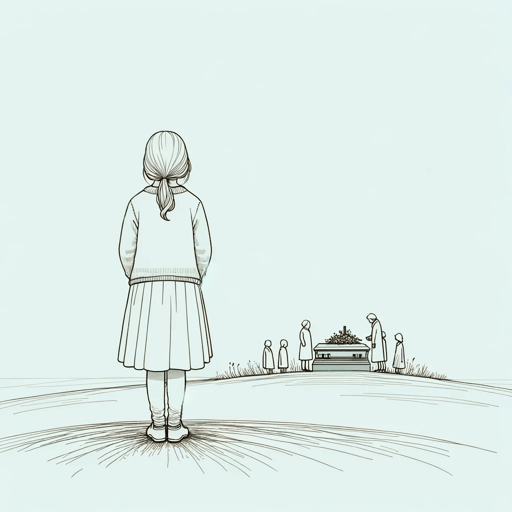30 pages • 1 hour read
Jamaica KincaidGirl
Fiction | Short Story | Adult | Published in 1978A modern alternative to SparkNotes and CliffsNotes, SuperSummary offers high-quality Study Guides with detailed chapter summaries and analysis of major themes, characters, and more.
Summary and Study Guide
Summary: “Girl”
Jamaica Kincaid’s “Girl” was first published on June 26, 1978 in The New Yorker and was later included in Kincaid’s debut 1983 short story collection, At the Bottom of the River. According to Kincaid, her works, including “Girl,” can be considered autobiographical. Kincaid grew up on the Caribbean island of Antigua and had a strained relationship with her mother before Kincaid moved to New York City. These same cultural and familial contexts are present in “Girl.”
This study guide cites the 1978 version of the text found in The New Yorker. Since the text is rather short and compact, references to direct quotes will include the respective line numbers in citations.
“Girl” is a dramatic monologue told predominantly in the second person. The text, which is considered a prose poem, follows no chronology and lacks a traditional plot structure. The speaker is presumed to be a mother preaching to her daughter, although their relationship is never clearly stated. The mother’s voice is exacting, and her speech cautionary. The story is a single paragraph comprised of a series of commands and instructions connected with a semicolon. The girl, having reached sexual maturity, receives instructions intended to help her become a respectable woman and is told how adults should behave. On two occasions, the daughter’s voice interrupts the mother in protest, but the mother merely continues with her monologue in a distant and often accusatory tone, using “don’t,” “do,” and “how to.” The story explores the detrimental gender roles and expectations imposed upon young girls who are emerging into womanhood.
Although the narrative is not linear, there is a tonal shift as the mother’s intention progresses from educating her daughter in domestic duties to empowering her to assert her individuality. The daughter’s voice also occasionally breaks through that of her domineering yet caring mother, giving readers a glimpse at the young, innocent girl who will soon be a woman.
Many of the mother’s directions include practical advice that will aid the girl in keeping a house of her own one day. She tells the girl to place freshly washed white clothing on a stone heap on Mondays and to save the color clothes to wash on Tuesdays. The mother also tells the daughter how to properly soak salt fish, cook pumpkin fritters, iron her father’s clothes, grow okra and dasheen, and sweep the house and yard. From these regional details, readers can infer that the story takes place in the British West Indies. The instructions suggest that the women reside in a poor rural setting in which imparting such advice is vital for daily life.
It also soon becomes apparent that the girl has approached sexual maturity. The speaker’s instruction to “soak your little cloths” when she removes them—a reference to menstruation—alludes to this fact. As the story progresses, it becomes clear that many of the mother’s directions are intended to prevent the girl from turning into the “slut” that her mother obviously believes the girl will become. She tells her not to sing benna (suggestive Antiguan folk songs) while in Sunday school, never to speak to the “wharf-rat boys,” and not to eat fruit on the street, as it will cause flies to follow her.
Such advice is interspersed with guidance about practical matters such as cleaning and cooking. She also tells the girl to avoid walking bareheaded in the sun. However, the mother’s main aim is to keep the daughter from becoming or being perceived as a “slut.” The mother’s commentary begins to introduce more serious issues such as etiquette and respectability, telling her to always walk like a lady and to be the “perfect” woman to fit into the community in which they live. The speaker also tells the girl about a medicine to induce abortion and observes that if her advice on how to love a man does not work, the girl should not regret giving up. She warns that men and women oftentimes “bully” one another.
The mother also provides social advice, telling the girl how to smile at anyone she does not like, as well as at those she sincerely likes. Furthermore, she informs her about how to avoid evil spirits. For example, she says what appears as a blackbird may indeed be something else entirely.
The delivery of the mother’s instruction suggests the ways in which adults model actions and behaviors for their children. Seemingly, the daughter is learning as she watches. Meanwhile, the speaker’s negative tone implies she has little hope that her daughter will progress into a decent state of adulthood, such that the girl’s protestation contributes to the tension of the story. In any case, the mother has the final word. At the end, when the daughter asks what she should do if the baker will not allow her to test the freshness of the bread by squeezing it, the mother wonders whether the girl will become the “kind of woman the baker won’t let near the bread” (Lines 52-53).
The mother’s advice comes across as castigating, caustic, and condescending. She passes on to her daughter the litany of female duties and attributes, developed and sanctified over generations, likely in the same manner the woman’s own mother had passed them on to her. The mother presents a generational gender mandate in the presence of an inevitable mother-daughter distancing typically signified by impending adolescence.
Related Titles
By Jamaica Kincaid
Featured Collections
Afro-Caribbean Literature
View Collection
Books that Feature the Theme of...
View Collection
Colonialism & Postcolonialism
View Collection
Colonialism Unit
View Collection
Coming-of-Age Journeys
View Collection
Community
View Collection
Mothers
View Collection
Required Reading Lists
View Collection





